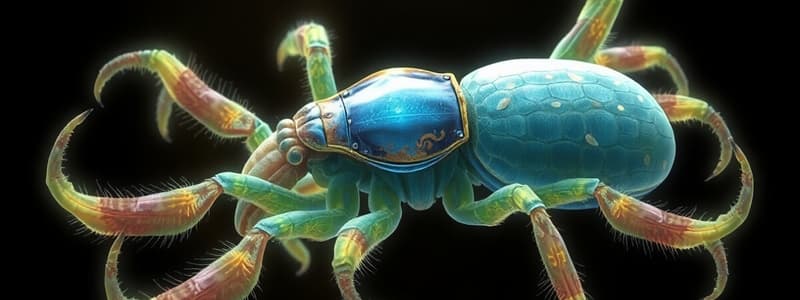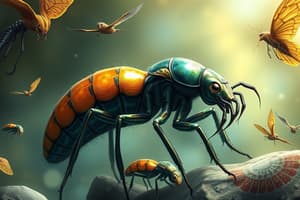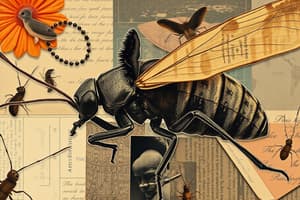Podcast
Questions and Answers
What is a prominent characteristic feature associated with Ecdysozoa?
What is a prominent characteristic feature associated with Ecdysozoa?
- Ecdysis, the process of molting (correct)
- Possession of cilia for movement
- Presence of a hard exoskeleton
- Having a closed circulatory system
Which of the following statements accurately distinguishes round worms (Nematodes) from those in the phylum Annelida?
Which of the following statements accurately distinguishes round worms (Nematodes) from those in the phylum Annelida?
- Nematodes have a complete digestive system. (correct)
- Annelids have a pseudocoelom.
- Nematodes possess segmented bodies.
- Nematodes often exhibit a cephalized structure.
What is a defining feature of Arthropod body structure?
What is a defining feature of Arthropod body structure?
- Lack of jointed appendages
- Presence of an endoskeleton
- Segmented body with a chitinous exoskeleton (correct)
- Soft-bodied without a hard shell
How do flight adaptations contribute to the success of insects?
How do flight adaptations contribute to the success of insects?
Which of the following correctly illustrates the difference between incomplete and complete metamorphosis?
Which of the following correctly illustrates the difference between incomplete and complete metamorphosis?
Which class do millipedes and centipedes belong to?
Which class do millipedes and centipedes belong to?
What type of circulatory system is found in arthropods?
What type of circulatory system is found in arthropods?
What function do tube feet serve in a sea star?
What function do tube feet serve in a sea star?
Which of the following examples belong to the phylum Echinodermata?
Which of the following examples belong to the phylum Echinodermata?
Which of the following functions can arthropod appendages serve?
Which of the following functions can arthropod appendages serve?
How does the water vascular system contribute to the functions of echinoderms?
How does the water vascular system contribute to the functions of echinoderms?
Which distinguishing feature separates millipedes from centipedes?
Which distinguishing feature separates millipedes from centipedes?
What are the primary body divisions of an arthropod?
What are the primary body divisions of an arthropod?
Which of the following accurately describes an open circulatory system?
Which of the following accurately describes an open circulatory system?
Which example best demonstrates complete metamorphosis?
Which example best demonstrates complete metamorphosis?
Which phylum do crustaceans belong to?
Which phylum do crustaceans belong to?
What is a key feature of the life cycle of organisms that undergo incomplete metamorphosis?
What is a key feature of the life cycle of organisms that undergo incomplete metamorphosis?
What is the primary characteristic of the Ecdysozoa group?
What is the primary characteristic of the Ecdysozoa group?
Flashcards
Ecdysozoa
Ecdysozoa
A major clade of animals that includes animals with a cuticle that needs to be shed for growth. This shedding process is called ecdysis.
Nematoda and Arthropoda
Nematoda and Arthropoda
Two phyla within Ecdysozoa. Nematoda includes roundworms, and Arthropoda includes insects, spiders, and crustaceans.
How do Nematodes differ from Annelids?
How do Nematodes differ from Annelids?
Nematodes are roundworms with unsegmented bodies and a pseudocoelom, while Annelids are segmented worms with a true coelom.
Arthropod body
Arthropod body
Signup and view all the flashcards
Arthropod appendages
Arthropod appendages
Signup and view all the flashcards
Open circulatory system
Open circulatory system
Signup and view all the flashcards
Millipedes and Centipedes
Millipedes and Centipedes
Signup and view all the flashcards
Flight in insects
Flight in insects
Signup and view all the flashcards
Incomplete Metamorphosis
Incomplete Metamorphosis
Signup and view all the flashcards
Ecdysis
Ecdysis
Signup and view all the flashcards
Nematodes
Nematodes
Signup and view all the flashcards
Annelids
Annelids
Signup and view all the flashcards
Open vs. Closed Circulatory System
Open vs. Closed Circulatory System
Signup and view all the flashcards
Arthropods' circulatory system
Arthropods' circulatory system
Signup and view all the flashcards
Millipede vs. Centipede
Millipede vs. Centipede
Signup and view all the flashcards
Complete vs Incomplete Metamorphosis
Complete vs Incomplete Metamorphosis
Signup and view all the flashcards
Study Notes
Invertebrate Study Guide
- Ecdysozoa: Characterized by molting (ecdysis).
- Ecdysozoan Phyla: Examples of studied phyla and their representatives
- Nematode vs. Annelid Worms: Distinguishing characteristics between roundworms (Nematodes) and segmented worms (Annelida).
- Arthropod Body Plan: Structure of an arthropod body. An arthropod body consists of segments and jointed appendages.
- Arthropod Appendages: Functions and adaptations of modified appendages.
- Open vs. Closed Circulatory Systems: Contrasting features and examples in arthropods.
- Millipede vs. Centipede: Key differences in classification and structure. (e.g., number of legs per body segment, chewing mouthparts).
- Insect Flight Success: The importance of flight in the success of insects. Flight is a key factor in insect success.
- Incomplete vs. Complete Metamorphosis: Differences and examples of each.
- Crustaceans: Phylum (Arthropoda), examples, and characteristics (e.g., crabs, lobsters, shrimp).
- Deuterostomia: Two major phyla included (examples needed).
- Sea Star Body Plan: Detailed structure, including the water vascular system. The water vascular system is a unique feature of echinoderms.
- Sea Star Tube Feet: Function and use (e.g., locomotion, feeding).
- Echinoderms: Examples of organisms (examples needed).
Studying That Suits You
Use AI to generate personalized quizzes and flashcards to suit your learning preferences.




